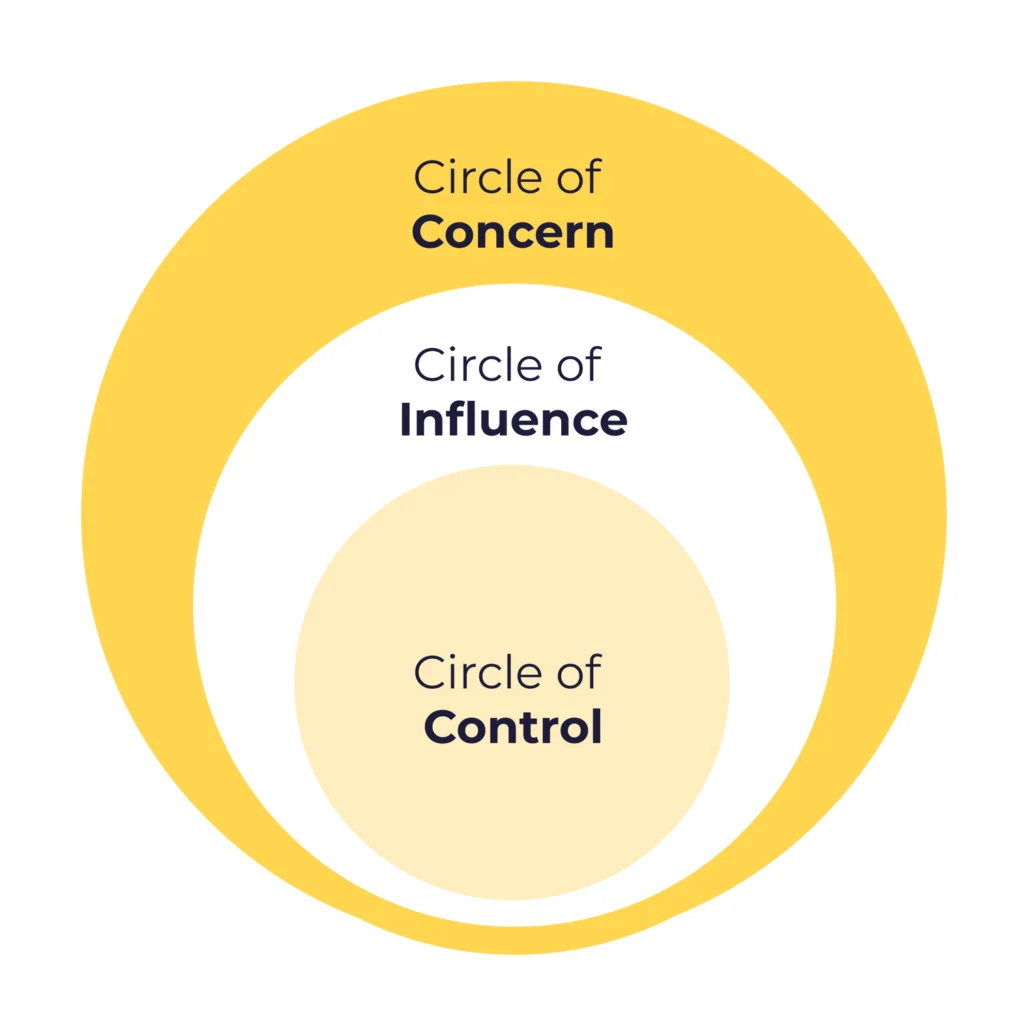In my years of coaching senior executives, one recurring theme keeps coming up: frustration with their work environment. Many share stories about difficult bosses, uncooperative colleagues, or systemic challenges that seem impossible to fix.
While these frustrations are valid, they often reveal a deeper issue—too much focus on the Sphere of Concern (things outside our control) and not enough attention on what we can control or influence.
This idea, popularized by Stephen Covey in The 7 Habits of Highly Effective People, has become a cornerstone of my coaching practice. It’s a simple yet transformative framework that helps leaders refocus their energy on areas where they can actually make a difference.
Understanding the Three Spheres
- Sphere of Control: The smallest yet most powerful sphere. It includes what you can directly manage—your actions, decisions, and mindset.
- Sphere of Influence: The middle ground. Here you can shape outcomes indirectly through relationships, persuasion, and collaboration.
- Sphere of Concern: The largest sphere, covering everything you care about but cannot change, such as other people’s behavior, company politics, or global trends.

The key to effective leadership and personal well-being is learning to focus your time and energy on the first two spheres while releasing what sits in the third.
Real-Life Coaching Examples
In one session, a senior executive spent much of our time venting about a boss whose unpredictable behavior was draining the team. They felt stuck, powerless, and frustrated.
Through reflection, it became clear that their attention was locked on their boss’s actions—squarely within the Sphere of Concern. Together, we shifted focus to what they could control and influence.
- Control: Manage their reactions by practicing emotional regulation and maintaining professionalism.
- Influence: Strengthen relationships with peers and higher-ups to create a support network and advocate for clearer communication.
Once they redirected their focus from frustration to action, their stress levels dropped and their credibility as a leader grew.
In another example, a client was frustrated by a colleague’s lack of effort on a shared project. This led to resentment and tense meetings. When we explored what was truly within their control, new possibilities emerged:
- Clarify expectations and deliverables in writing.
- Offer support or find common ground to align goals.
Instead of waiting for the colleague to change—a hope firmly planted in the Sphere of Concern—the client took initiative. The result was smoother collaboration and stronger outcomes.
Why Leaders Get Stuck in the Sphere of Concern
Focusing on external problems can feel satisfying in the moment. Venting provides temporary relief, but it often traps us in a cycle of stress and helplessness. This mindset can lead to:
- Burnout: Energy drains when you dwell on what you can’t change.
- A Victim Mindset: Feeling powerless erodes confidence and drive.
- Missed Opportunities: Time spent worrying is time not spent acting.
Research shows that focusing on what you can control builds resilience and well-being. Leaders who adopt this mindset handle challenges more effectively and model calm confidence for their teams.
Practical Strategies for Refocusing
Here’s how to bring this framework into your leadership practice:
- Identify Your Stressors: Write down what’s bothering you, then categorize each item under Control, Influence, or Concern. Seeing it on paper often clarifies where your attention truly lies.
- Act Within Your Sphere of Control: Focus on your own actions—how you respond, communicate, and prioritize. For example, if deadlines are slipping due to external factors, adjust timelines or redistribute workloads instead of dwelling on delays.
- Expand Your Sphere of Influence: Build trust through consistent communication. Engage stakeholders and advocate for changes that align with shared goals.
- Let Go of the Sphere of Concern: Acknowledge what you cannot change and consciously redirect your energy toward what you can. Instead of worrying about market conditions, focus on strategies your team can use to adapt and thrive.
The Transformational Impact
When leaders shift from the sphere of concern to control and influence:
- They feel more empowered and less stressed.
- Their teams benefit from clarity and stronger direction.
- They produce better results by focusing energy where it truly counts.
One client described this shift as “liberating.” By letting go of frustrations about office politics and concentrating on relationships within their sphere of influence, they built stronger alliances and secured buy-in for a major initiative—something they once thought was out of reach.
A Final Thought
As leaders, it’s natural to care deeply about many things: your team, your organization, even the world around you. But caring doesn’t mean controlling.
The most effective leaders focus their energy on what they can do today to create a better tomorrow. So the next time you feel overwhelmed or stuck, pause and ask yourself:
Am I focusing on what I can control or influence?
That simple shift in perspective can transform your leadership, your impact, and your sense of fulfillment.


